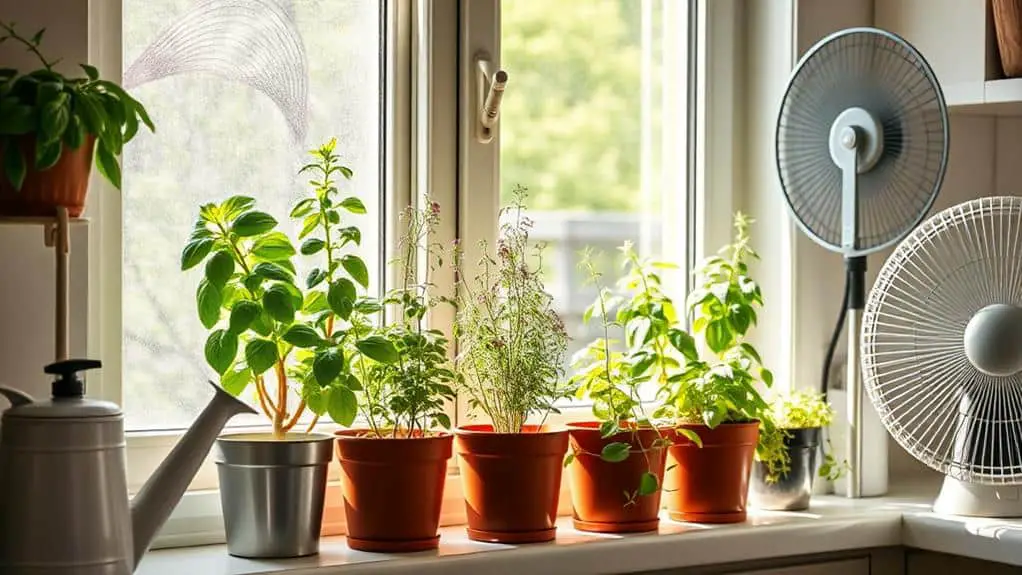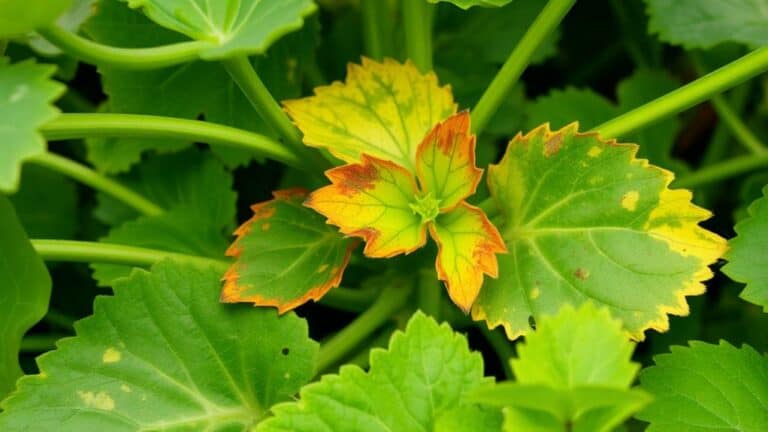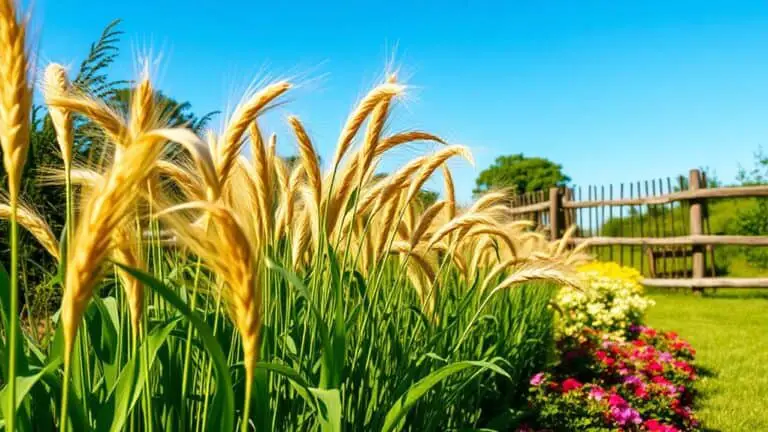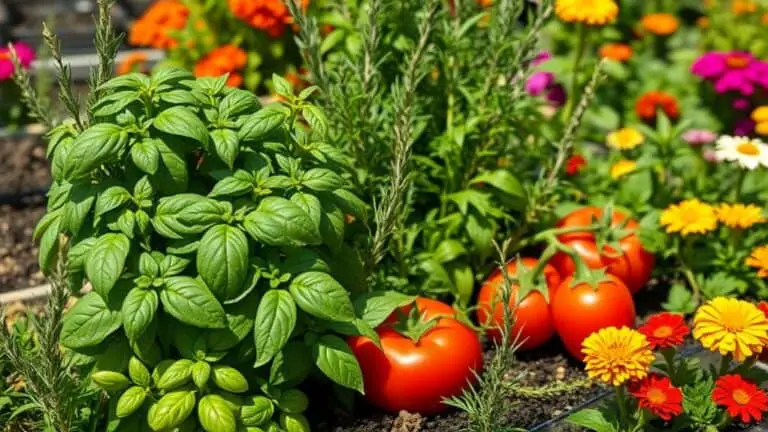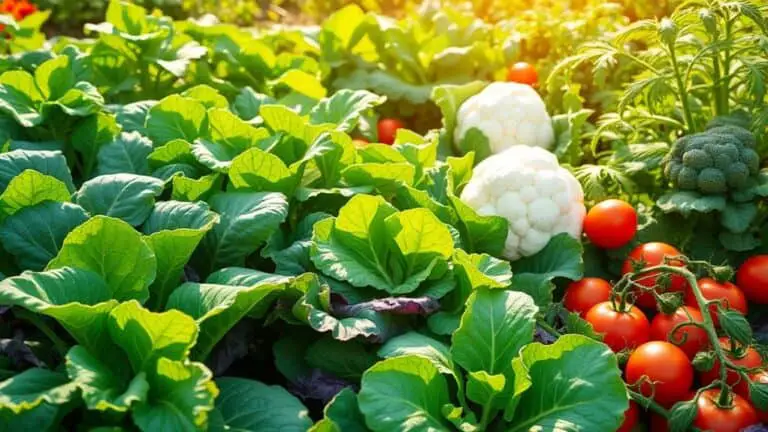How To Keep Potted Herbs Alive Inside All Winter
When winter sets in, keeping potted herbs alive indoors can be a bit challenging, but it's definitely doable with some careful planning. To start, choosing the right herbs like sage and rosemary is vital since they're more resilient to indoor conditions. Proper lighting is another key factor, so placing your herbs near a south-facing window or using grow lights can make a significant difference. Managing soil moisture and ensuring good drainage are also essential to avoid root rot. But that's just the beginning. Want to know how to tackle humidity, temperature control, and more? Let's explore further.
Choosing the Right Herbs
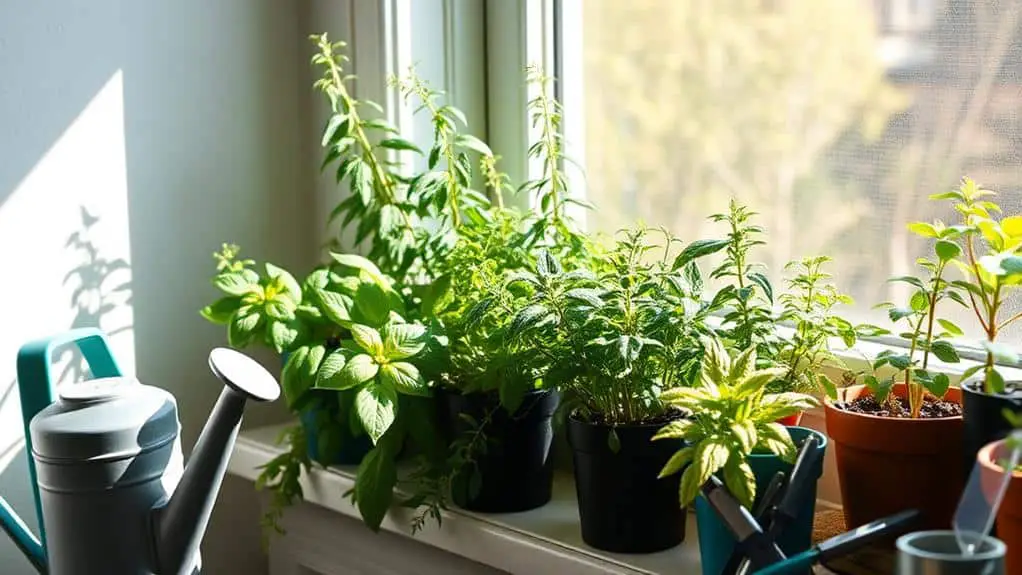
When it comes to keeping potted herbs alive inside all winter, choosing the right herbs is essential. Focus on hardier varieties like sage, rosemary, thyme, and lavender. These herbs can thrive indoors despite lower light and temperature changes.
Avoid tender herbs like basil, dill, and cilantro, as they struggle in these conditions. Look for plants with large, healthy leaves and strong stems. Avoid those with flowers or wispy leaves, as they might be seeding.
Clump-forming herbs like oregano and mint are also great choices since they can be divided for better growth in pots.
Remember to take into account each herb's specific light and humidity needs to guarantee they survive and flourish throughout the winter.
Inspecting for Pests
Before bringing your potted herbs indoors, thoroughly inspect the leaves for signs of pests like discolored spots or webbing.
Use a strong blast of water to remove any visible pests and prune damaged leaves to promote plant health.
Once inside, keep up with regular health checks and consider a soap-water spray to manually remove any pests that might appear.
Inspect Leaves Thoroughly
Inspecting the leaves of your indoor herbs thoroughly is essential to keep them healthy and pest-free all winter. Regularly inspect leaves for signs of pests like aphids, spider mites, and whiteflies.
These pests can quickly damage your plants if not addressed. Look for webbing or sticky residue, which indicates spider mites. Prune any damaged or discolored leaves to encourage healthy growth and prevent infestations from spreading.
Establish a routine inspection schedule, ideally every week, to catch any pest issues early. A quick blast of water can help remove visible pests before bringing herbs indoors.
Manual Pest Removal
Manual pest removal is a hands-on approach that can save your potted herbs from potential infestations. Regular inspections are key to maintaining a pest-free environment.
Here's how I do it:
- Inspect and Clean: Before bringing herbs indoors, I inspect them thoroughly and use a water blast from a hose to dislodge any unwanted insects.
- Regular Checks: I check leaves and stems for pests like webs or discolored spots. Early detection is essential.
- Prune and Spray: I prune damaged leaves and use a soap-water spray to remove visible pests, ensuring my herbs stay healthy.
Healthy plants are better equipped to adapt to indoor conditions. By incorporating these steps, you can keep your indoor herb garden thriving all winter long.
Regular Health Checks
Keeping pests at bay is just the beginning; maintaining the overall health of your potted herbs throughout winter involves regular health checks.
You should inspect your indoor herbs weekly for signs of pest infestations like aphids or spider mites. Catching these early prevents damage. If you see pests, a strong water blast or a gentle spray from a bottle can dislodge them.
Prune any damaged or discolored leaves to keep your plants healthy and less attractive to pests. A soap-water spray can also help, but test it on a small leaf first.
These regular health checks will guarantee your herbs stay healthy and vibrant all winter long. It's all about staying vigilant and proactive.
Transplanting Techniques
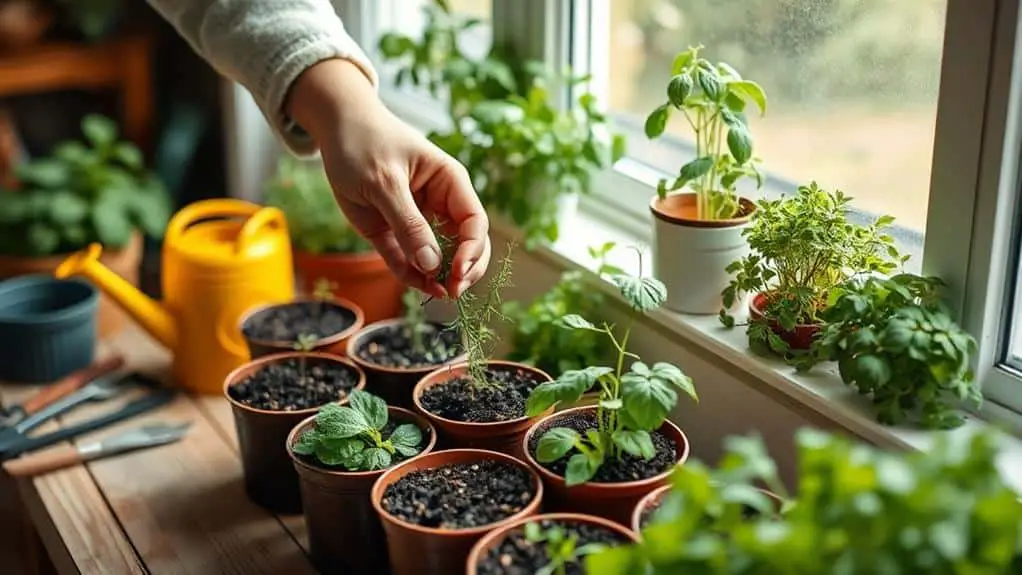
Transplanting herbs from your garden to indoor pots for the winter can be a rewarding process if done with care. Here's how I do it:
- Dig Carefully: Before the first frost, use a long, thin trowel or hori hori to dig up the herbs. This minimizes root disturbance and keeps the soil intact.
- Inspect the Herbs: Check for pests and prune any damaged or discolored leaves. Healthy plants adapt better indoors.
- Gradually Acclimate: Start by placing the herbs in bright, indirect light. After a week, move them to a spot with at least four hours of direct sunlight.
These transplanting techniques will help your herbs thrive indoors all winter.
Selecting Proper Containers
When selecting containers for your indoor herbs, aim for pots that are at least 6 inches deep to give the roots enough room to grow.
Choose wide metal tubs or terra cotta pots since they provide good drainage and help keep the soil moist.
Don't forget to line the bottom with landscaping cloth and guarantee the pots have drainage holes to prevent root rot.
Deep Root Accommodation
Choosing the right containers for your potted herbs is essential to guarantee they thrive indoors during winter. Deep root accommodation is crucial, so make sure your pots are at least 6 inches deep. This gives the roots plenty of space to grow and access nutrients from the potting soil.
Terra cotta or wide metal tubs are great choices because they offer stability and excellent drainage.
Here are three tips to keep in mind:
- Use containers with drainage holes—this prevents water from pooling and causing root rot.
- Line the bottom with landscaping cloth—it keeps soil in while letting excess water escape.
- Choose a slightly larger pot—extra space around the root ball helps roots develop and strengthens the plant.
Happy gardening!
Drainage and Airflow
Selecting the right containers for your potted herbs is essential for ensuring proper drainage and airflow. I recommend choosing pots with drainage holes at the bottom. This prevents water from accumulating, which can cause root rot.
Deep containers, at least 6 inches tall, are ideal as they provide enough room for roots and allow for good airflow around the root system. Terra cotta pots work great since they breathe and help regulate moisture.
For extra help, line the bottom of your pot with landscaping cloth or mesh to stop soil from spilling but still let water drain. Wide metal tubs or larger containers offer more surface area for airflow, reducing humidity buildup and keeping your herbs healthy.
Material and Size
Finding the perfect container for your potted herbs can make all the difference in their winter survival. I always make certain to pick the right containers to give my herbs the best chance.
Here's what you need to do:
- Choose Deep Pots: Select containers that are at least 6 inches deep to accommodate the root ball and guarantee healthy growth.
- Use Terra Cotta: These pots are great for air circulation and moisture control, which helps prevent root rot.
- Guarantee Drainage: Always pick pots with drainage holes at the bottom to let excess water escape. You can line them with landscaping cloth to prevent soil spillage while still allowing for good drainage.
Following these tips, your herbs will thrive all winter long!
Ensuring Adequate Lighting
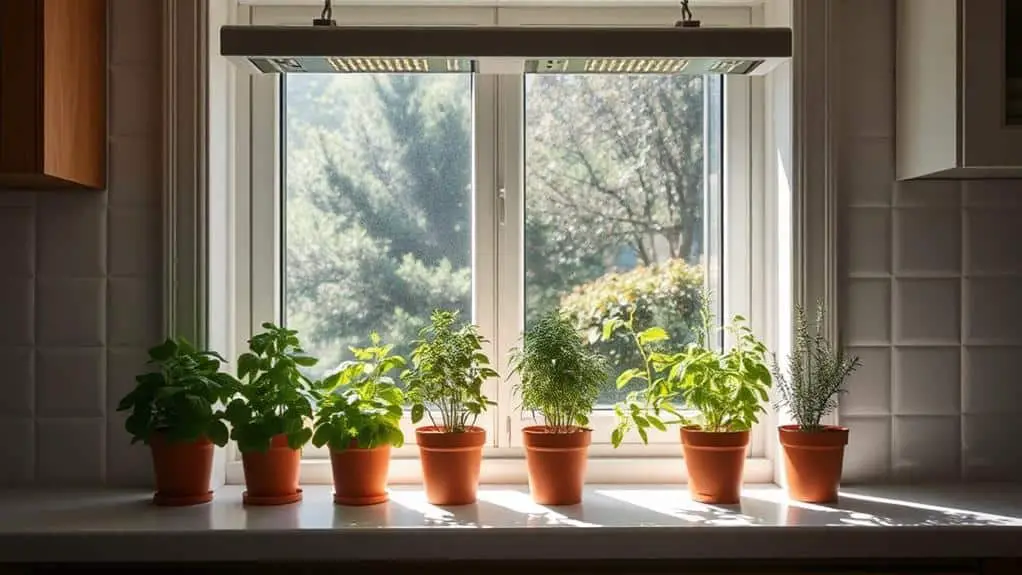
Ensuring proper lighting is essential for keeping your potted herbs thriving indoors all winter. Most herbs need at least six hours of direct sunlight daily, so placing them by south-facing windows is ideal.
Herbs like basil, parsley, and oregano thrive with direct sunlight, while mint and rosemary can tolerate some indirect light. If natural light is scarce, use full spectrum grow lights for 14-16 hours daily for adequate lighting.
Watch for signs like thin, spindly stems, which indicate your herbs aren't getting enough light. Make sure to position pots where nothing blocks the sunlight.
Watering Correctly
Now, let's talk about watering your potted herbs correctly.
First, always check the soil moisture by feeling the top inch—if it's dry, it's time to water.
Make sure water drains out the bottom of the pot, but don't let it sit in standing water to avoid root rot.
Check Soil Moisture
One of the most essential steps to keeping your potted herbs thriving indoors all winter is to monitor soil moisture carefully.
Before you water your plants, always check soil moisture by feeling the top inch of soil. If it feels dry, it's time to water. Overwatering can cause yellowing leaves and wilting, so it's vital to avoid it.
Here's what you need to do:
- Check the top inch of soil: Only water your plants when this layer feels dry.
- Water thoroughly: Make certain water drains out from the bottom of the pot.
- Empty saucers promptly: Prevent standing water from suffocating the roots.
Following these steps will help you keep your herbs healthy and happy all winter long!
Ensure Proper Drainage
Many indoor gardeners struggle to keep their potted herbs alive all winter, but proper drainage can make all the difference.
First, verify your pots have adequate drainage holes. These let excess water escape, preventing overwatering and root rot.
Always use a well-draining potting mix, which helps maintain the right moisture levels around your herb roots.
Check the soil regularly and water only when the top inch is dry. Before watering, remove any plastic sleeves from the pots.
Remember to empty the saucers under your pots promptly to avoid water accumulation.
Avoid Overwatering Risks
Overwatering is the silent killer of potted herbs, often leading to yellow leaves and wilting plants.
To keep your herbs healthy, it's essential to check soil moisture before adding water. Here's a simple guide to avoid overwatering:
- Check Soil Moisture: Only water your herbs when the top inch of soil feels dry to the touch. This prevents roots from sitting in saturated conditions.
- Ensure Proper Drainage: Use pots with holes at the bottom to allow excess water to escape. This stops standing water from causing root rot.
- Empty Saucers: Always empty saucers under pots after watering. This avoids water accumulation that can harm your plants.
Maintaining Humidity
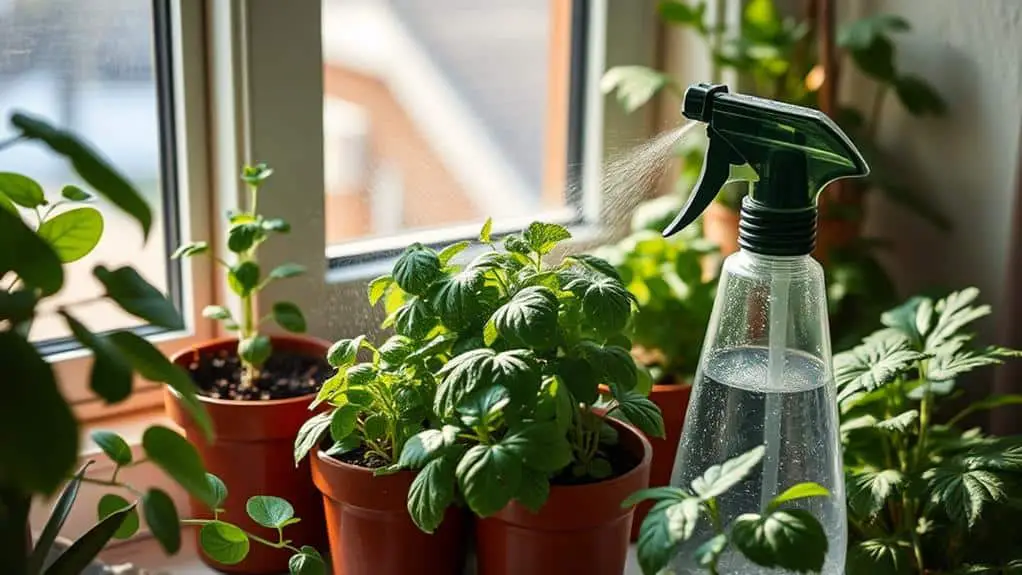
Maintaining adequate humidity is essential for keeping your potted herbs thriving indoors during the winter months. Herbs love moisture, so misting them with water periodically is a great way to boost humidity levels.
Another trick is to place your pots on a tray filled with moist pebbles. This helps increase humidity without submerging the pots. Grouping your herbs together can create a microclimate with higher humidity, but be careful as this might reduce air circulation.
Using a humidifier in the room can also guarantee the air stays moist. Aim to keep the humidity above 40% to prevent stress and promote healthy growth. Monitoring these levels will help your herbs stay resilient and happy.
Temperature Control
To keep your potted herbs alive indoors all winter, temperature control is paramount. You'll need to maintain consistent warmth to guarantee peak growth.
During the day, keep temperatures between 65°F and 75°F. At night, aim for a cooler range of 55°F to 60°F.
Here's how you can achieve this:
- Use a thermometer: Regularly monitor the indoor temperature to keep it within the ideal range.
- Avoid drafty spots: Place your herb pots away from drafty windows or heating vents to prevent cold drafts or excessive heat.
- Consistent warmth: Make sure the temperature doesn't fluctuate too much, as this can stress your plants.
Regular Pruning
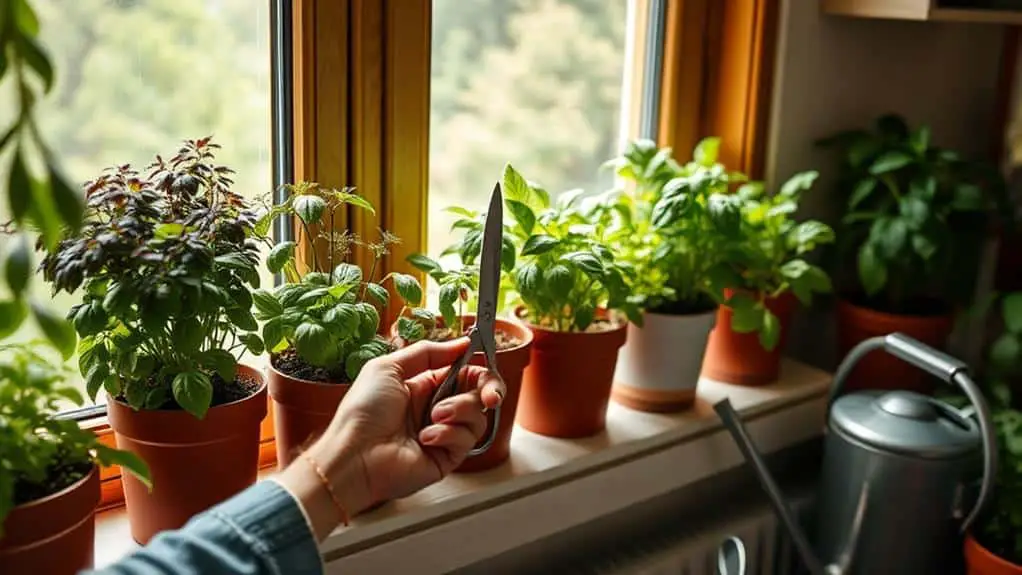
Pruning your potted herbs regularly is essential for keeping them healthy and thriving through the winter. Regular pruning encourages bushier growth by stimulating new leaf production. Aim to remove about one-third of the plant to keep herbs alive and vigorous.
Focus on trimming back any damaged or discolored leaves, as this improves the herb's overall health. For annual herbs like cilantro and dill, regular harvesting is key since they'll eventually bolt and complete their life cycle.
Use clean, sharp scissors to make precise cuts, which helps prevent damage and promotes faster healing. Frequent pruning also enhances the flavor of your herbs while maintaining their size and preventing overcrowding in pots.
Follow these steps, and your herbs will flourish indoors all winter long.
Propagating Cuttings
When it comes to propagating cuttings, starting with healthy stems from soft-stem herbs like basil and mint is crucial.
Here's a simple guide to help you get started:
- Select and Prepare Cuttings: Choose disease-free stems, 4-6 inches long. Remove lower leaves to expose leaf nodes.
- Water and Light: Place cuttings in clean water, submerging the nodes. Position the container on a sunny windowsill to guarantee they receive adequate light.
- Transplanting: Once roots are about 2 inches long, transfer them into pots with well-draining potting soil.
Change the water every few days to keep it fresh and oxygenated.
This promotes faster root growth and prevents rot.
With these steps, you'll have healthy, thriving herb cuttings ready to grow all winter.
Frequently Asked Questions
Will Herbs Survive Winter in Pots Indoors?
Yes, many herb varieties can survive winter indoors if you provide proper care. I guarantee they get enough indoor lighting, maintain suitable humidity levels, and monitor soil moisture. This keeps my herbs healthy all winter.
How Do You Winterize Potted Herbs?
To winterize potted herbs, I place them in a bright spot with six hours of sunlight or use grow lights. I check soil moisture regularly, watering only when the top inch is dry, and guarantee proper drainage.
How Cold Is Too Cold for Potted Herbs?
I've found that herb temperature preferences vary, but most indoor herb varieties struggle below 50°F. Keeping them cozy, monitoring humidity levels, and avoiding cold drafts guarantees they stay healthy even when it's chilly out.
How Do You Care for Potted Herbs Indoors?
To care for potted herbs indoors, I make certain they get proper indoor lighting, stick to a consistent watering schedule, and keep an eye out for pests. This helps my herbs thrive, even during winter.
Conclusion
Keeping your potted herbs alive indoors all winter isn't as hard as it seems. By choosing the right herbs, ensuring they get enough light, and maintaining proper moisture and temperature, you'll find success. Don't forget to check for pests and prune regularly. Try propagating cuttings to expand your garden. With these steps, you'll enjoy fresh herbs all season. Trust yourself and have fun with your indoor gardening adventure. You've got this!

